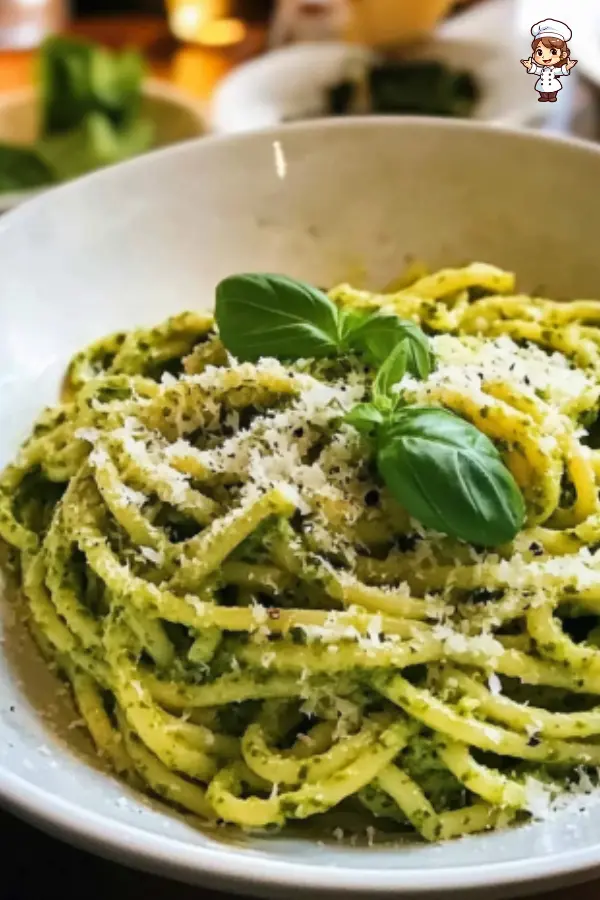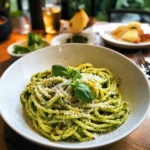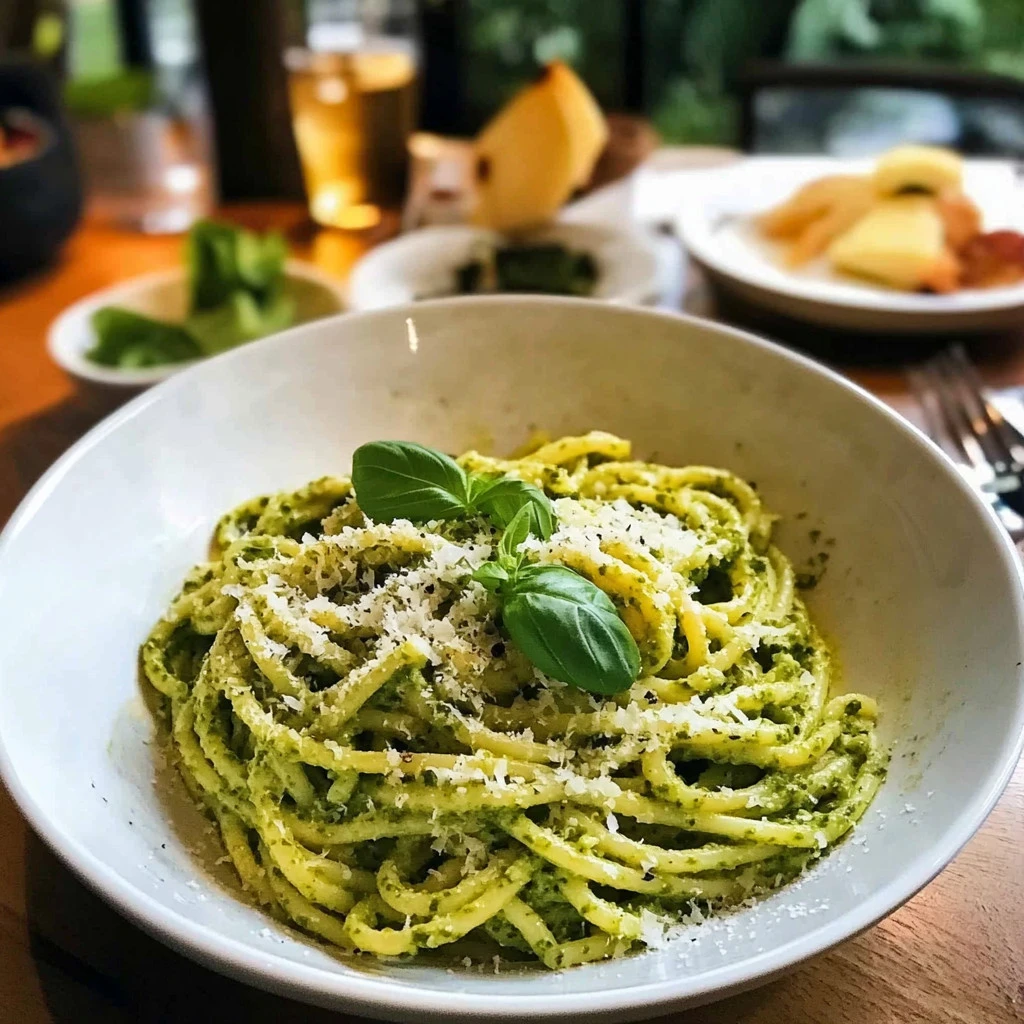Pesto Pasta is a dish that has earned a special place in the hearts of many pasta lovers around the world. This vibrant dish is simple yet flavorful, featuring pasta coated in a fresh and aromatic pesto sauce. Pesto, an Italian classic, is traditionally made with basil, garlic, pine nuts, Parmesan cheese, and olive oil. Combined with your choice of pasta, it creates a delightful meal that’s quick to prepare and bursting with Italian flair.
Whether you’re looking for a comforting weeknight dinner or a dish to impress your friends at a dinner party, Pesto Pasta is versatile enough for any occasion. In this article, we will explore the ingredients, directions, and serving suggestions to help you create the perfect Pesto Pasta. Let’s dive deeper into this delicious dish!
Ingredients about Pesto Pasta
List of Ingredients with Measurements
To make an amazing Pesto Pasta, you will need the following ingredients:
- Pasta (spaghetti, penne, or your choice) – 400g (14 oz)
- Fresh basil leaves – 2 cups packed
- Garlic – 2 to 3 cloves
- Pine nuts – 1/3 cup
- Parmesan cheese (grated) – 1/2 cup
- Olive oil – 1/2 cup
- Salt – to taste
- Black pepper – to taste
Optional Ingredient Substitutions
If you can’t find some of these ingredients or want to make adjustments, here are some alternative options:
- Pasta: You can use gluten-free pasta or zucchini noodles for a low-carb alternative.
- Nuts: Swap pine nuts with walnuts, almonds, or even sunflower seeds for a different flavor.
- Cheese: If you’re vegan or lactose intolerant, try using nutritional yeast instead of Parmesan or omit it entirely.
- Herbs: Besides basil, you can blend in spinach, parsley, or arugula for unique flavor variations.
How to Make Pesto Pasta Directions

Step 1: Prepare the Pasta
Start by boiling a large pot of salted water. Once boiling, add your chosen pasta and cook according to the package instructions, usually around 8-10 minutes for al dente texture. Stir occasionally to prevent sticking. When done, reserve about 1 cup of pasta water, and then drain the pasta in a colander.
Step 2: Make the Pesto
While the pasta is cooking, prepare the pesto. In a food processor, combine the fresh basil, garlic cloves, pine nuts, and a pinch of salt. Pulse the mixture a few times to break down the ingredients. Scrape down the sides of the bowl, then add the grated Parmesan cheese, and continue to blend until smooth. With the processor running, slowly drizzle in the olive oil until the pesto reaches a creamy consistency. Adjust seasoning with more salt and pepper, if desired.
Step 3: Combine Pasta and Pesto
In a large mixing bowl or the same pot used for cooking the pasta, combine the drained pasta with the prepared pesto. Toss the pasta well to ensure every strand is coated with the flavorful sauce. If the pesto is too thick, add a little of the reserved pasta water until you achieve your desired consistency.
Step 4: Serve Immediately
Once well mixed, your Pesto Pasta is ready to be served. Transfer it to a serving dish and add a sprinkle of grated Parmesan cheese and some extra pine nuts on top, if you like. Enjoy your homemade dish with a drizzle of olive oil for an extra touch!
How to Serve Pesto Pasta
Best Ways to Serve Pesto Pasta
Pesto Pasta is best served fresh, immediately after making it. The bright green aroma of the basil and the tangy cheese create an unforgettable dish. You can serve it warm or at room temperature, making it versatile for various occasions.
Serving Suggestions or Pairings
To elevate your meal, consider pairing your Pesto Pasta with:
- A side salad with fresh greens, cherry tomatoes, and a light vinaigrette.
- Grilled chicken or shrimp for added protein.
- Crispy garlic bread to soak up any leftover sauce.
- A glass of white wine, such as Sauvignon Blanc or Pinot Grigio, for a delightful experience.
How to Store Pesto Pasta
Proper Storage Methods
If you have leftover Pesto Pasta, store it in an airtight container in the refrigerator. It can stay fresh for up to 3 days. Make sure to let it cool down before sealing to prevent condensation.
Tips for Reheating or Freezing
To reheat, add a splash of water or olive oil to the pasta and heat it in the microwave for about 1-2 minutes, or in a pan over low heat. For freezing, portion the pasta and pesto separately in freezer-safe containers. The pasta can be frozen for up to 3 months, while the pesto can last even longer. Thaw both in the fridge overnight before reheating.
Tips to Make Pesto Pasta
Common Mistakes to Avoid
- Overcooking the Pasta: Make sure to cook your pasta al dente to keep a bit of bite. Overcooking can lead to mushy pasta.
- Using Old Ingredients: Fresh basil and quality olive oil make a significant difference. Avoid using dried herbs or low-quality oils for the best flavor.
- Not Tasting: Always taste your pesto during preparation! Adjust the salt, pepper, and cheese levels as needed.
Helpful Tips for Better Results
- Blanch the Basil: To preserve the vibrant green color, briefly blanch the basil leaves in boiling water before making the pesto.
- Use a Mortar and Pestle: For a more traditional approach, use a mortar and pestle instead of a food processor. It brings out deeper flavors and a different texture.
- Experiment: Feel free to add additional ingredients like lemon juice for brightness, or red pepper flakes for heat.
Variation of Italian Pesto Dish
Suggested Variations or Twists on the Recipe
You can easily put your spin on Pesto Pasta. Some creative variations include:
- Sun-Dried Tomato Pesto Pasta: Incorporate sun-dried tomatoes into the pesto for a different flavor profile.
- Spinach Pesto: Replace a portion of the basil with fresh spinach for added nutrients and a unique taste.
- Nut-Free Option: Use roasted chickpeas or nutritional yeast instead of nuts for a nut-free version.
Adjustments for Dietary Preferences
If you follow specific dietary habits, here are some adjustments you can make:
- Vegan Pesto Pasta: Use nutritional yeast in place of cheese and skip any meat additions.
- Gluten-Free: Choose gluten-free pasta options available in stores or make your own from chickpeas or lentils.
- Low-Carb: Zucchini noodles (zoodles) or spaghetti squash are excellent substitutes for traditional pasta.
FAQs
What can I do if the dish isn’t turning out right?
If your Pesto Pasta isn’t tasting as expected, double-check the balance of seasoning. You can add salt, pepper, or more cheese to enhance flavors. If it’s too dry, adding a small amount of reserved pasta water or olive oil can help.
Can I make this ahead of time?
Yes! Pesto can be made a day in advance, and the pasta can also be cooked beforehand. Combine them just before serving to maintain flavor and texture.
What can I substitute for ingredients?
If you don’t have pine nuts, feel free to use walnuts or pumpkin seeds. Olive oil can be substituted with avocado oil or sunflower oil if necessary. The essence of pesto lies in the basil and garlic, so try to keep those as your main ingredients.
Pesto Pasta is not only a delicious meal but also a canvas for creativity, allowing you to explore flavors and techniques. With its straightforward preparation and minimal ingredients, it makes for a perfect entry point into Italian cooking. Enjoy this delectable dish with loved ones and make lasting memories around the table!
Print
Pesto Pasta
- Prep Time: 10 minutes
- Cook Time: 10 minutes
- Total Time: 20 minutes
- Yield: 4 servings 1x
- Category: Main Course
- Method: Blending, Boiling
- Cuisine: Italian
- Diet: Vegetarian
Description
Pesto Pasta is a simple yet flavorful dish that combines fresh basil, garlic, Parmesan, and olive oil. Perfect for any occasion, it’s easy to make and delicious.
Ingredients
- 400g pasta (spaghetti, penne, or your choice)
- 2 cups packed fresh basil leaves
- 2–3 garlic cloves
- 1/3 cup pine nuts
- 1/2 cup grated Parmesan cheese
- 1/2 cup olive oil
- Salt to taste
- Black pepper to taste
- Optional: 1/2 cup parsley or spinach for variation
Instructions
- Boil salted water in a large pot. Cook pasta according to package instructions, about 8-10 minutes for al dente. Reserve 1 cup pasta water and drain.
- In a food processor, combine basil, garlic, pine nuts, salt, and pulse until broken down. Add Parmesan and blend until smooth. Gradually drizzle in olive oil until pesto reaches desired consistency.
- In a large mixing bowl, toss cooked pasta with pesto. If needed, add reserved pasta water for a smoother sauce.
- Serve immediately, garnished with extra Parmesan and pine nuts. Optionally, drizzle with olive oil and enjoy!
Notes
- For gluten-free, use gluten-free pasta or zucchini noodles.
- Try walnuts, almonds, or sunflower seeds as alternatives to pine nuts.
- If vegan, substitute Parmesan with nutritional yeast or omit it.
Nutrition
- Serving Size: 1 serving
- Calories: 350
- Sugar: 2g
- Sodium: 400mg
- Fat: 22g
- Saturated Fat: 3g
- Unsaturated Fat: 18g
- Trans Fat: 0g
- Carbohydrates: 30g
- Fiber: 3g
- Protein: 9g
- Cholesterol: 10mg
Keywords: Pesto Pasta, pesto recipe, Italian pasta, basil pesto, garlic pesto pasta, easy pasta recipe

